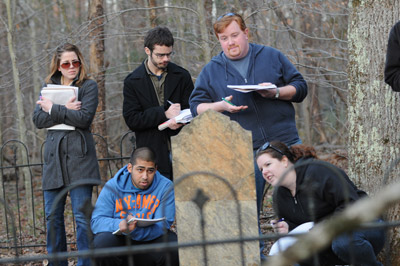Having Fun With History (Mills Kelly)

Several years ago I decided that university level history students just weren’t having enough fun in their classes. By not having enough fun I don’t mean to say that history majors aren’t enjoying their studies of the past. I see plenty of evidence that the students in my department like what they study, get a high degree of personal satisfaction from their work, and are glad to be history majors. But I don’t see them having very much fun.
It seems reasonable to ask whether we should even be worried whether or not a university education in history is fun or not. If the object of our endeavors as educators is to stimulate learning among our students, why do they need to have fun at the same time they learn? One reason for having fun in a history class is that the more we are enjoying something, the more we tend to be engaged with it. We look forward to things that are fun and dread those that feel like drudgery. The more students are having fun in a course, the more actively they will be engaged with the material they are studying, and I think we can all agree that active engagement has some sort of positive learning outcome. I would also ask, “Why not have fun?”
Several years ago, I decided to deal with the “fun deficit” in my courses. I rewrote my historical methods course to make it more challenging, more research focused, and more “outdoorsy.” Students in that class (titled Dead in Virginia) now spend time out in the field and in the archives researching local family cemeteries. They publish the results of their work online for the benefit of other historians, and they tell me they really enjoy getting their hands dirty (quite literally) in the pursuit of answers to mysteries posed by what they find (and don’t) in their research.
I also created a new course called Lying About the Past. In this course my students work in teams to create plausible historical hoaxes that they then turn loose online for two weeks (and no more) to see if they can fool anyone. When I created the course, it seemed to me that historical hoaxes were, in and of themselves, fun to study. By creating a hoax of their own, the students would be not only having fun, but would exercise their creative energies in the online environment. Given that they are now just as much content creators as content consumers in the digital world, this latter point has been especially important to the course.
Both courses are very rigorous and require more work from the students than they expect when they sign up. In each, my students are challenged to think about the past in ways they have not before. They have to find it, get face to face with it, touch it, fake it, and publicize it to a wider audience.
Do they have fun doing all of these things? What I see in the classroom and what they report back to me at the end of the semester is that they have lots of fun. Do they learn more? I think “more” is the wrong metric, because it implies that there is some sort of universal standard for measuring more or less historical learning in a particular course. So much of what we are trying to do in our work as educators is to help students develop their own ways of knowing about the past. Instead of “more,” I would say they learn many of the same things we’ve been teaching them for years, but in different ways. And at least in the case of the hoax course, they also learn a degree of skepticism about the veracity of online sources that they do not learn anywhere else.
What I do know for sure, though, is that they come to class early, stay late, and display the highest levels of engagement with the substantive aspects of the courses that I’ve seen in almost twenty years of college teaching. And they laugh and chuckle their way through the entire semester.
What could be wrong with that?
- Se connecter ou créer un compte pour soumettre des commentaires
- Français

